Nicole schreibt...
Marrakesh 2024 |
 |
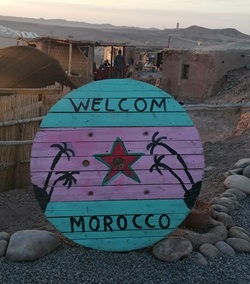 Many years ago, when I was a teenager with little travel experience, we went on a package tour holiday to the Moroccan seaside resort of Agadir, which back then seemed overwhelmingly exotic. From there we did a day trip to the fabled city of Marrakesh at the foot of the Atlas Mountains, but that was even more overwhelming with the chaos of the souks and the (back then completely unfamiliar) hassling and haggling of the local vendors. So ultimately I can't say that I really enjoyed the trip or really felt like I had experienced Morocco properly.
Years passed in which I started travelling all over the world, while Marrakesh blossomed into a new trendy city destination that eventually got my attention again. One thing that really tickled me was the transformation of classical Riads – the local residences built around an open inner courtyard – into guest houses, allowing you to wallow in a bit of a dream of 1001 Nights rather than staying in some bland hotel. It also tickled me far more as a winter destination to gather some sunlight and warmth than the bland Canary Islands I was well and truly over with after the trip to Gran Canaria.
Many years ago, when I was a teenager with little travel experience, we went on a package tour holiday to the Moroccan seaside resort of Agadir, which back then seemed overwhelmingly exotic. From there we did a day trip to the fabled city of Marrakesh at the foot of the Atlas Mountains, but that was even more overwhelming with the chaos of the souks and the (back then completely unfamiliar) hassling and haggling of the local vendors. So ultimately I can't say that I really enjoyed the trip or really felt like I had experienced Morocco properly.
Years passed in which I started travelling all over the world, while Marrakesh blossomed into a new trendy city destination that eventually got my attention again. One thing that really tickled me was the transformation of classical Riads – the local residences built around an open inner courtyard – into guest houses, allowing you to wallow in a bit of a dream of 1001 Nights rather than staying in some bland hotel. It also tickled me far more as a winter destination to gather some sunlight and warmth than the bland Canary Islands I was well and truly over with after the trip to Gran Canaria.
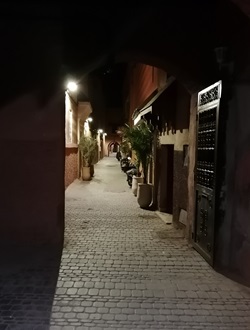
It helped that Ryanair offered direct flights from Cologne to Marrakesh (although getting back would be more difficult) and so we were off in late January to finally revisit Morocco’s pink city of which I remembered almost nothing. Arriving in the evening after dark we were picked up at the airport by our chosen Riad’s driver who took us into the Medina (the old town) as far as cars were allowed, where we were met by the Riad's owner to walk the rest of the way – less than five minutes but down shady deserted lanes, that are not quite the introduction to a new foreign city you might want! But of course this was simply due to the local architecture and the riads' nearly windowless outer walls that keep out the heat and the sun. I grew to actually love the stillness of the alleys after dark when you might only encounter a cat out on the prowl. Here's a night-time picture of our alley as well as some pictures of our wonderful Riad Atlas Acacia:
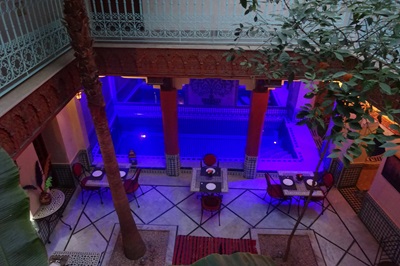
|
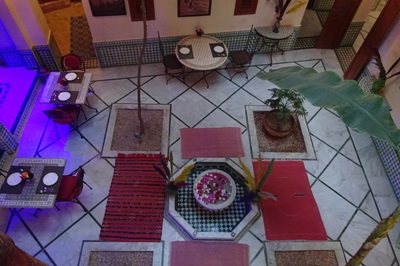 |
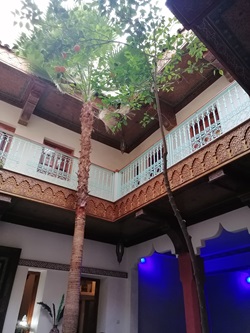
|
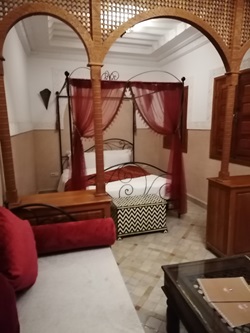
|
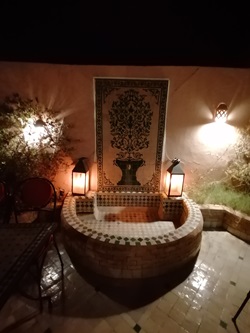 |
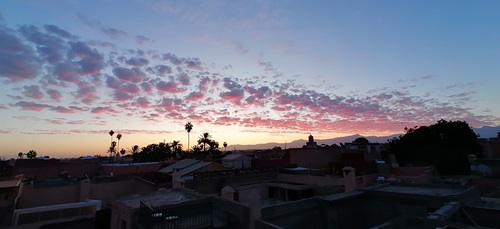 Above is the view looking down into the open courtyard with its central fountain, seating area and pool/jacuzzi, followed by a look up to the first floor with the four converted guest rooms and the lovely rooftop with another fountain and seating area and yet another level with sunloungers and a wonderful view across the rooftops of the medina to the Atlas Mountains in the distance. And a gorgeous sunrise every morning that was not to be missed despite extremely frigid temperatures.
Above is the view looking down into the open courtyard with its central fountain, seating area and pool/jacuzzi, followed by a look up to the first floor with the four converted guest rooms and the lovely rooftop with another fountain and seating area and yet another level with sunloungers and a wonderful view across the rooftops of the medina to the Atlas Mountains in the distance. And a gorgeous sunrise every morning that was not to be missed despite extremely frigid temperatures.
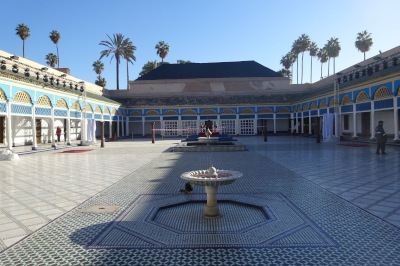
Next morning the trip began properly with a visit to Bahia Palace (which was almost next door), a grand mansion with architecture to absolutely die for (La Bahia literally means The Beautiful). Grand Vizier Si Moussa, who had risen from humble slave to the Sultan's cherished advisor had started it in the 1860s, but it was his son Abu 'Bou' Ahmed who turned it into the splended place it is now. Like most islamic art and architecture it thrives on breathtakingy intricate handiwork and a very symmetric design that isn't always easy to capture on camera, but here are a few attempts.
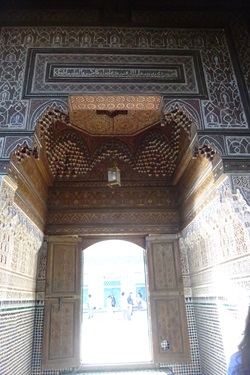
|
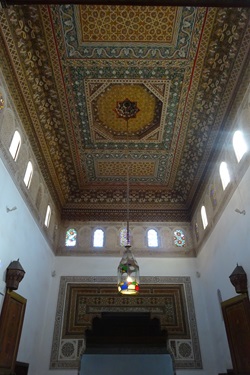
|
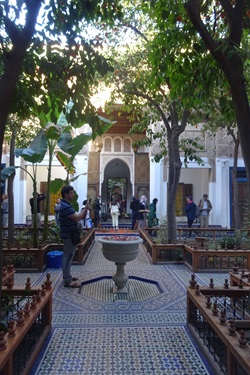 |
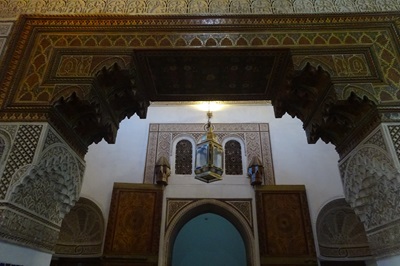
|
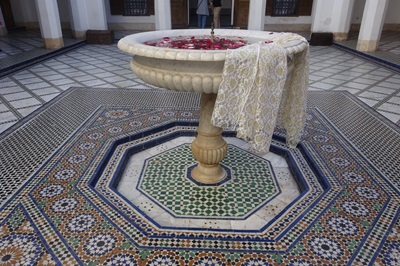 |
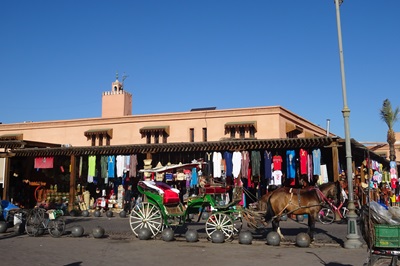 Just a hop away from Bahia Palace was what became my favourite place in Marrakesh, the Place des Ferblantiers, the square of the iron workers, also known as Place Mellah for being in the old Jewish quarter of Mellah. It had some lovely restaurants and cafes with outdoor seating, a mix of touristy and normal shops and didn't feel half as insane as fabled Jamaa el-Fna - which was our next destination after a little detour for a look at Marrakesh's most famous landmark, the Koutoubia Mosque (covered in sheeting as so many famous sights are when I visit). Since infidels are not allowed to enter anyway, we proceeded to Jamaa el-Fna, the world-famous square that has been in use as a market square since 10th century and is now a UNESCO World Heritage Site.
Just a hop away from Bahia Palace was what became my favourite place in Marrakesh, the Place des Ferblantiers, the square of the iron workers, also known as Place Mellah for being in the old Jewish quarter of Mellah. It had some lovely restaurants and cafes with outdoor seating, a mix of touristy and normal shops and didn't feel half as insane as fabled Jamaa el-Fna - which was our next destination after a little detour for a look at Marrakesh's most famous landmark, the Koutoubia Mosque (covered in sheeting as so many famous sights are when I visit). Since infidels are not allowed to enter anyway, we proceeded to Jamaa el-Fna, the world-famous square that has been in use as a market square since 10th century and is now a UNESCO World Heritage Site.
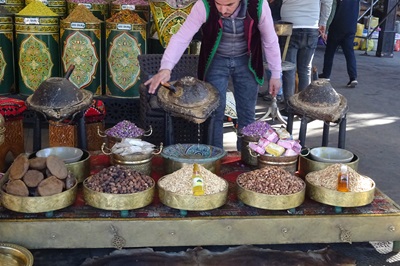
|
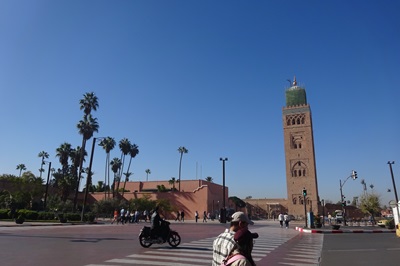 |
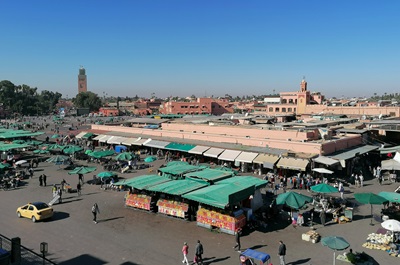 Here's the view over the Jamaa el-Fna from the rooftop terrace of the famous Café de Paris, which has been around since 1912. During the day it's mostly occupied by fruit juice sellers (with the best freshly squeezed orange juice I've ever tasted), henna-painting ladies and various vendors selling touristy stuff.
It truly comes into its own after sunset when not only several food stalls set up shop but you get a glimpse of the old-style entertainments of yore: The famous storytellers, who've been passing on stories for centuries to groups of listeners, the snake charmers and the water sellers in their fancy costumes. It does feel like a massive fun fair with local families and groups of young people strolling around just as much as the many tourists.
Here's the view over the Jamaa el-Fna from the rooftop terrace of the famous Café de Paris, which has been around since 1912. During the day it's mostly occupied by fruit juice sellers (with the best freshly squeezed orange juice I've ever tasted), henna-painting ladies and various vendors selling touristy stuff.
It truly comes into its own after sunset when not only several food stalls set up shop but you get a glimpse of the old-style entertainments of yore: The famous storytellers, who've been passing on stories for centuries to groups of listeners, the snake charmers and the water sellers in their fancy costumes. It does feel like a massive fun fair with local families and groups of young people strolling around just as much as the many tourists.

|
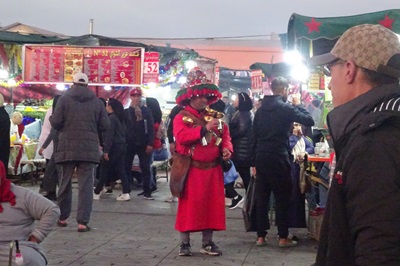 |
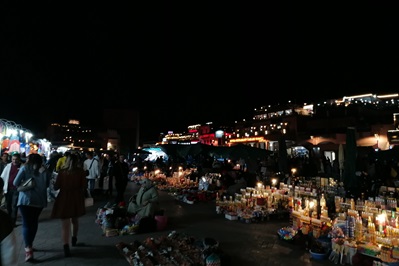
|
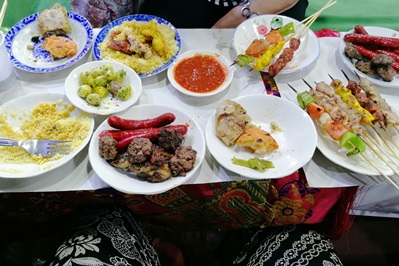 |
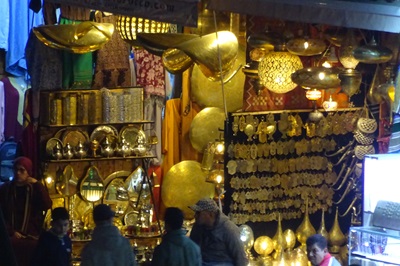 Jamaa el-Fnaa also forms one end (or entrance) of Marrakesh's famous souks, a chaotic warren of lanes and alleys lined with endless little shops and stalls. Although I really don't like haggling and usually feel like I've been cheated anyway, I had made it my main mission to buy a proper Moroccan lamp here as well as a gorgeous and stupidly comfortable caftan. And while I really can't tell whether I got a good price or not, I did get both a lovely lamp and comfy caftan for prices that seemed reasonable to me, so I came out of the souks a happy camper.
Jamaa el-Fnaa also forms one end (or entrance) of Marrakesh's famous souks, a chaotic warren of lanes and alleys lined with endless little shops and stalls. Although I really don't like haggling and usually feel like I've been cheated anyway, I had made it my main mission to buy a proper Moroccan lamp here as well as a gorgeous and stupidly comfortable caftan. And while I really can't tell whether I got a good price or not, I did get both a lovely lamp and comfy caftan for prices that seemed reasonable to me, so I came out of the souks a happy camper.
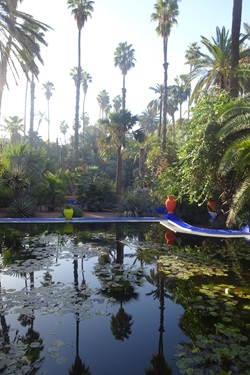
Next morning we were back on the tourist trail for that other biggie in Marrakesh, the Jardin Majorelle, slightly out of town (and thus a feast for every taxi driver happy to rip off tourists). Jacques Majorelle was a French painter who settled down in Marrakesh in 1917 and created the garden as his very own oasis with plants from all over the world. He even conceived his own very intense (and trademarked) Majorelle Blue (which you can buy in paint cans in the souvenir shop, should you feel the desire to copy him). He gifted the garden to the city of Marrakesh, which had almost sold it to property developers, but no one less than fashion designer Yves Saint-Laurent interfered and bought the place as a hidey hole for himself and his partner Pierre Bergé. Both got themselves a memorial in the garden for their trouble and a museum nearby, while Majorelle's studio inside the garden is now a small but interesting museum dedicated to regional berber culture.
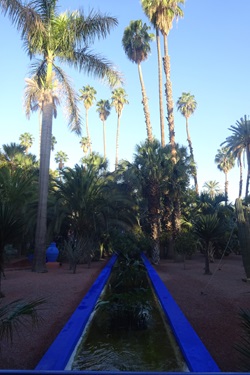
|
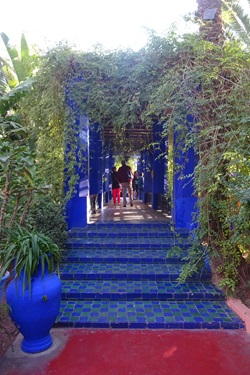
|
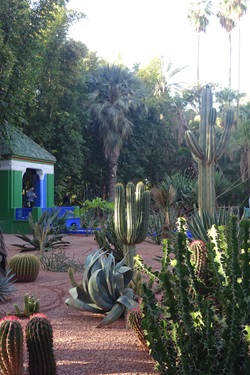 |
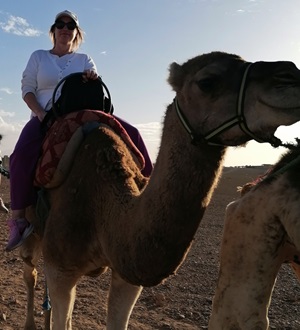
One of my main plans for this trip had been to do a day trip to Ouarzazate in the Atlas Mountains, partly to see the ancient berber city for itself and partly because it's home to the Atlas Film Studios where virtually every movie and TV show set in some desert location has been filmed (including, once again, "Game of Thrones"). But in the end a full day trip seemed like too much for such a short city trip, so instead I booked us a half-day outing into the Agafay Desert near Marrakesh which included a quick camel ride (mostly just to take pictures and have something to tell the folks at home, I guess) and an evening with barbecue and entertainment in a desert camp, which came complete with an incredibly beautiful sunset and some good traditional Moroccan tajine food.
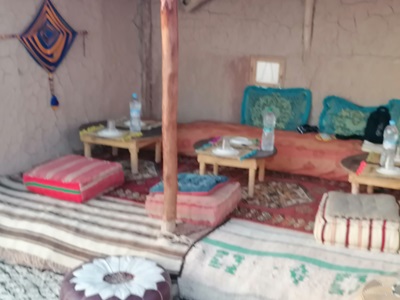
|
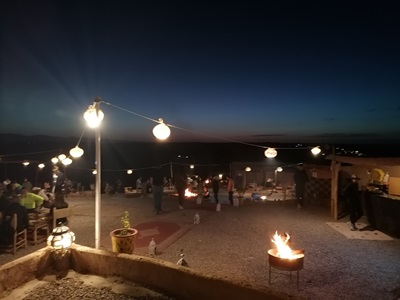 |
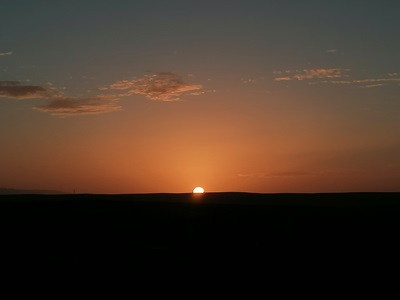
|
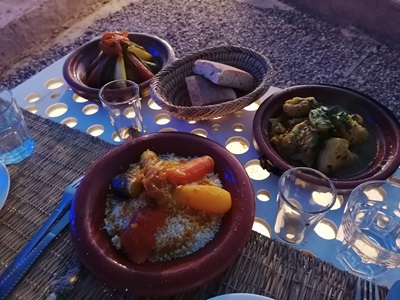 |
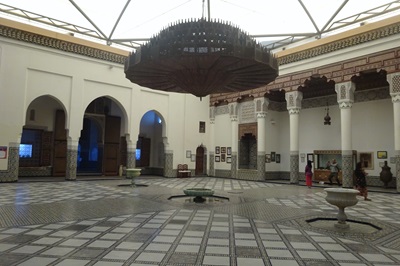 One final sightseeing trip into the city took us to the Musée the Marrakesh first, yet another lovingly transformed old palace, whose centerpiece was this massive iron-wrought chandelier that weighs in at 1200 kilograms. As exhibitions went, it was a little bit disappointing, teaching me not much about the city itself.
One final sightseeing trip into the city took us to the Musée the Marrakesh first, yet another lovingly transformed old palace, whose centerpiece was this massive iron-wrought chandelier that weighs in at 1200 kilograms. As exhibitions went, it was a little bit disappointing, teaching me not much about the city itself. Basically next door is the Ali Ben Youssef Medersa, the largest Quran School in all of North Africa once upon a time and now open to the public as a major tourist draw. You can stroll around the main courtyard and peek into some of the many tiny rooms where once the students lived and which very much reminded me of monastic cells.
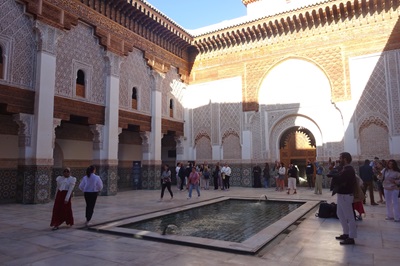
|
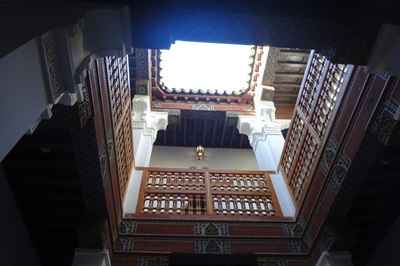 |
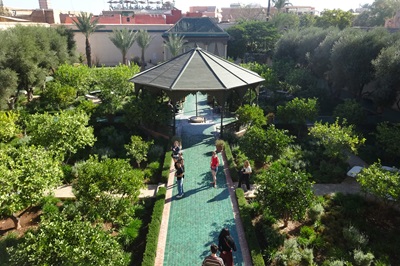 One last and rather overpriced stop was the so-called Secret Garden that was created a good 400 years ago, when water was still brought to Marrakesh from the Atlas Mountains through aquaducts and then distributed in rather clever fashion to water the gardens. Now it's a wonderful oasis of peace in the middle of the crazy souks and a good place to rest before heading back to Jamaa el-Fna for a lunch stop and then to the riad for a proper oriental hamam treatment and massage.
One last and rather overpriced stop was the so-called Secret Garden that was created a good 400 years ago, when water was still brought to Marrakesh from the Atlas Mountains through aquaducts and then distributed in rather clever fashion to water the gardens. Now it's a wonderful oasis of peace in the middle of the crazy souks and a good place to rest before heading back to Jamaa el-Fna for a lunch stop and then to the riad for a proper oriental hamam treatment and massage.
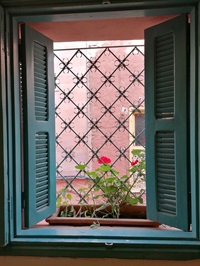 And so the trip ended in a wonderfully relaxing fashion before making our way home from Marrakesh via Madrid and Düsseldorf. It really does strike me as amazing how you really needn't fly all the way to South East Asia or similar places to experience a world completely different to our own when Morocco is less than a four hour flight away and how differently I felt about being there now with years of travel experience under my belt. Marrakesh was just as enchanting and crazy as I had hoped it would be and while I'm not all that keen on the haggling in the souks and the blatant attempts to rip off tourists, I suppose it's just part of the charm in that part of the world. It also reminded me that, while I loved the crazy trips to New York and look forward to the next one already, it's also good to get out there and see different parts of the world and cultures from time to time...
And so the trip ended in a wonderfully relaxing fashion before making our way home from Marrakesh via Madrid and Düsseldorf. It really does strike me as amazing how you really needn't fly all the way to South East Asia or similar places to experience a world completely different to our own when Morocco is less than a four hour flight away and how differently I felt about being there now with years of travel experience under my belt. Marrakesh was just as enchanting and crazy as I had hoped it would be and while I'm not all that keen on the haggling in the souks and the blatant attempts to rip off tourists, I suppose it's just part of the charm in that part of the world. It also reminded me that, while I loved the crazy trips to New York and look forward to the next one already, it's also good to get out there and see different parts of the world and cultures from time to time...
Copyright © All Rights Reserved